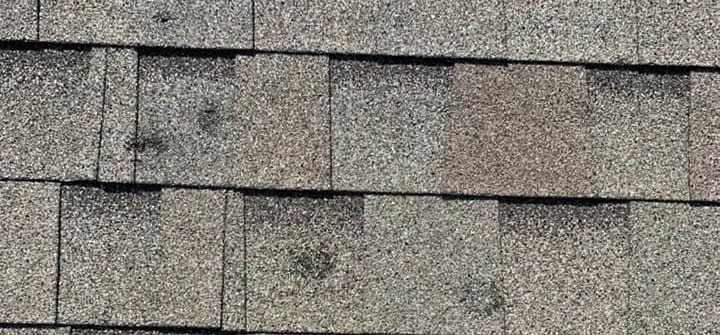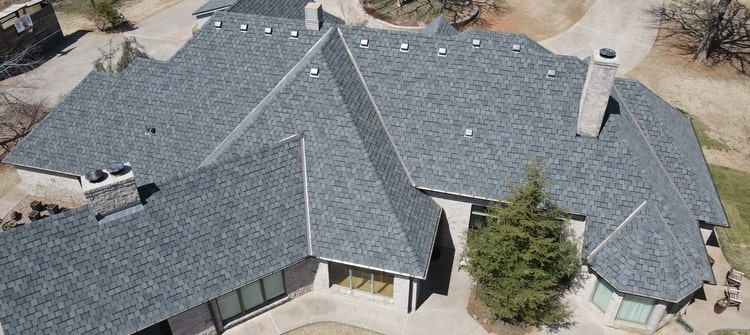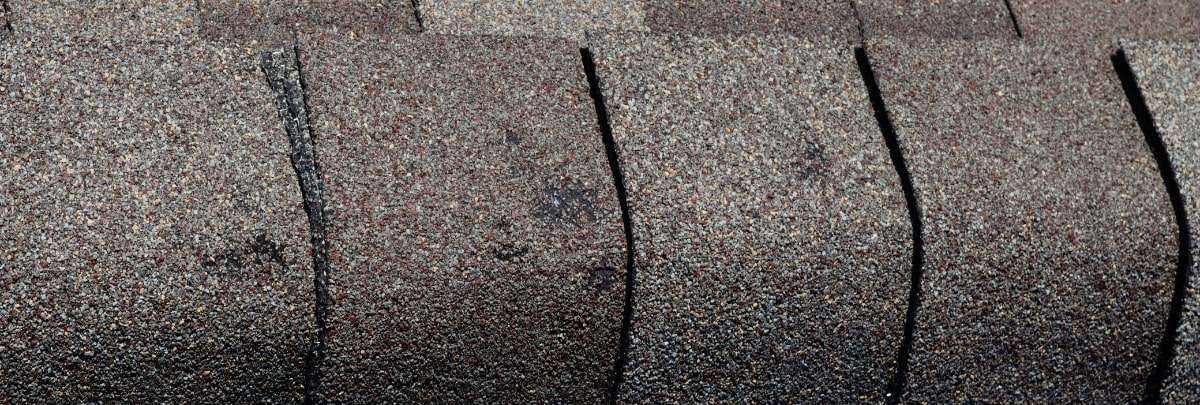Granular loss on roofs is a common yet often overlooked condition that affects the longevity and performance of asphalt shingles. By understanding these elements, Oklahoma homeowners and building managers can better protect their investments and maintain the integrity of their roofs.
This detailed exploration will explore the reasons behind granular loss, its detrimental effects on buildings, and the best practices for preventing such damage.
What is Granular Loss on Roofs?
Granular loss refers to the shedding of the ceramic-coated granules from asphalt shingles. These granules are crucial as they protect the asphalt coating from UV rays and heat, which can accelerate the roof’s aging process. Over time, various factors can lead to the erosion of these granules, exposing the asphalt to elements and potentially leading to significant roof damage.
The Basics of Asphalt Shingles and Their Composition
Asphalt shingles are North America’s most popular roofing material due to their cost-effectiveness and durability. These shingles comprise a fiberglass mat topped with asphalt and coated with ceramic granules. The granules protect the roof from UV rays and heat while providing aesthetic value.
Identifying Granular Loss on an Oklahoma Roof
Granular loss on your roof is an issue that shows up as transparent, bare patches on the shingles. This happens when the tiny, protective granules that cover the shingles fall off. Identifying this problem can help you take timely action to prevent further damage.
Here’s how you can spot granular loss:
- Check for Bare Spots: Look for areas on your shingles that seem smoother and less textured compared to others. These spots have lost their granules, exposing the underlying asphalt or fiberglass mat.
- Inspect After Weather Events: Strong weather events, such as hail storms or heavy rains, can knock granules loose. After such events, inspect your roof for any signs of uneven surface texture.
- Observe Your Gutters and Downspouts: One of the most evident signs of granular loss is finding loose granules in your gutters or collected at the downspouts. After rainfall, take a moment to check these areas for granule accumulations.
- Feel the Texture: If you are on the roof for any maintenance, gently run your hand over the surface of the shingles. Areas that have lost granules will feel significantly smoother than those that haven’t.
- Look for Color Differences: Areas of your roof with granular loss might also show color differences. The exposed mat may appear darker or differently colored compared to areas still covered with granules.

Common Causes of Granular Loss
Understanding why granular loss occurs is vital to preventing it.
Various factors, ranging from physical impact to the quality of the roofing material, can lead to the shedding of granules from roof shingles.
Physical Impact
- Hail: Strong hailstorms can hit shingles hard enough to knock the granules loose.
- Falling Branches: When tree branches fall onto the roof during storms or due to weak tree health, they can scrape off the granules.
- Foot Traffic: Walking on the roof for inspections, repairs, or during installation can also cause granules to detach.
Age and Weathering
- Sun Exposure: Continuous exposure to UV rays can make shingles brittle and increase their likelihood of losing granules.
- Temperature Fluctuations: Repeated heating and cooling throughout the seasons can cause shingles to expand and contract, loosening granules.
- Rain and Wind: Prolonged exposure to harsh weather conditions like rain and wind can wear down shingles over time, resulting in granular loss.
Poor Quality Material
- Inferior Shingle Composition: Cheaper or poorly manufactured shingles may not have a robust adhesive to hold the granules in place.
- Low-Quality Granules: If the granules are not of high quality, they may not adhere well to the shingle surface, making them easier to dislodge.
Faulty Installation
- Improper Nailing: Shingles need to be nailed in a particular way. Nails that are driven in too tightly can create stress points where granules are more likely to break free.
- Incorrect Shingle Alignment: If shingles are not aligned correctly, it can lead to uneven wear and tear, which promotes granular loss.
Addressing these causes, you can proactively maintain your roof’s integrity and extend its lifespan. Regular inspections and immediate roof repairs in Oklahoma are crucial when dealing with any signs of granular loss.
Impacts of Granular Loss
Granular loss can significantly compromise the health and appearance of your roof. Understanding the consequences of this condition is essential for maintaining a robust roofing system.
Decreased Lifespan of the Roof
- Vulnerability to UV Rays: Shingles are more exposed to UV radiation without their protective coat of granules, which can accelerate their deterioration.
- Thermal Damage: The granules also help in reflecting heat. Without them, shingles absorb more heat, which can warp and damage the material, leading to a need for earlier roof replacement.
Aesthetic Degradation
- Uneven Appearance: Granular loss can leave patches of bare shingles that stand out against the rest of the roof, creating a patchy, unattractive appearance.
- Reduced Property Value: A roof in poor condition can deter potential buyers and may reduce the overall value of your property due to the anticipated repair expenses.
Increased Roof Repairs
- Quick Degradation: Exposed shingles degrade faster under environmental conditions. This can lead to cracks, leaks, and other structural problems.
- Higher Repair Costs: If the roof’s integrity is compromised, you might need emergency roof repairs, which can be costly if they can’t be completed quickly.
Taking proactive steps to prevent granular loss, such as choosing high-quality materials and regular maintenance, is crucial to mitigate these impacts and ensure the longevity of your roof.

Strategies for Prevention and Mitigation
Effective prevention of granular loss extends the life of your roof and saves money on repairs and replacements.
Here are some key strategies to prevent granular loss from compromising your roof’s integrity:
Regular Roof Inspections
- Schedule Bi-annual Inspections: It’s advisable to inspect your roof twice a year and after significant weather events like storms or high winds. This helps you spot and address granular loss early before it leads to severe damage.
- Focus on Problem Areas: Pay extra attention to areas vulnerable to wear and tear, such as roof valleys and areas near chimneys and vents.
Choosing Quality Materials
- Select Reputable Brands: Use shingles from well-known, reputable manufacturers to ensure you get a product that meets industry standards.
- Look for Durability Features: Opt for shingles specially designed to resist weather conditions prevalent in your area, such as high winds, hail, or intense sunlight.
Proper Installation
- Hire Experienced Contractors: Ensure that the roofing contractors you hire are certified and have a good track record. Proper installation is crucial to prevent early granular loss.
- Monitor Installation Practices: It’s essential to ensure contractors follow best practices for nailing and aligning shingles, as poor installation can significantly weaken the granules’ bond.
Adequate Ventilation
- Ensure Good Airflow: Proper ventilation in the attic and roof area helps regulate temperature and moisture levels. This can prevent the roofing material from becoming too hot, which protects the adhesive qualities of the granules.
- Check and Maintain Vents: Regularly check that your roof’s vents are not blocked and are adequate to handle the square footage of your roof space. Proper ventilation extends the granules’ life and the roof’s overall structure.
Advanced Granular Loss Prevention Techniques
Beyond basic maintenance, advanced methods are available to further protect your roof from granular loss. These techniques can extend the life of your roof and improve its overall resilience against environmental threats.
Using Roof Coatings
- Apply Protective Sealants: Coating your roof with a protective sealant can lock the granules in place and shield the asphalt layer from UV rays and moisture, which can accelerate wear.
- Choose the Right Type of Coating: Use a coating compatible with your roofing material. This enhances the roof’s resistance to weather and improves its overall aesthetic and functional longevity.
Trimming Overhanging Trees
- Prevent Physical Damage: Keep nearby trees well-trimmed to avoid branches scraping against the roof during windy conditions, which can dislodge granules.
- Reduce Debris Accumulation: Trimming trees also minimizes the leaves and debris that fall on the roof, which can retain moisture and contribute to granule loss.
Gutter Maintenance
- Regular Cleaning: Ensure your gutters are cleaned at least twice a year to prevent blockages that can cause water to pool and overflow. This overflow can wear down the edges of your roof, where granule loss is most likely.
- Check for Proper Alignment: Gutters should be properly aligned and securely attached to facilitate efficient water flow away from the roof. This reduces the risk of water damage and granular erosion at the roof’s edges.

When Granular Damage Occurs
If you notice granular loss on your roof, it’s crucial to decide whether to repair the affected areas or replace the roof entirely. The right decision can save you money and extend your roof’s life.
Addressing Granular Loss: Repair or Replace?
When facing a granular loss on your roof, the decision to either repair or replace it depends heavily on the extent of the damage and the age of the roof.
Here are some practical steps to help you make the best decision for your roof’s condition:
Evaluate the Extent of Granular Loss
- Localized Damage: If the granular loss is limited to a few small areas, spot repairs can typically fix these. This is a cost-effective solution that can extend the life of your roof without needing a total replacement.
- Widespread Damage: In cases where granular loss is extensive and affects large portions of the roof, it’s often more sensible to consider a total replacement. This ensures that all potential underlying issues are addressed.
Consider the Age of Your Roof
- Near End of Life: If your roof is older and nearing the end of its typical lifespan (20-25 years for asphalt shingles), replacing it might be the better investment. At this age, ongoing repairs will likely be a temporary fix.
- Relatively New Roof: Repairs may suffice to correct the issue for newer roofs experiencing premature granular loss, especially if the rest of the roof is in good condition.
Assess the Overall Condition of the Roof
- Inspect for Additional Issues: Look beyond granular loss for other potential problems, such as leaks, sagging, or damage to structural elements. If multiple areas are affected, replacement might be necessary.
- Check for Cosmetic Issues: If the aesthetic impact of granular loss is significant, replacing the roof could improve your home’s appearance and value.
Get Professional Advice
- Consult With a Roofing Expert: A qualified roofing contractor can provide a thorough inspection and explain your options based on the current state of your roof.
- Compare Repair and Replacement Costs: Get estimates for both repairs and replacement. This comparison can help you understand the most cost-effective solution, considering long-term maintenance and potential energy savings with a new roof.
Plan for the Future
- Consider Long-Term Costs: Weigh the immediate cost of repairs against the potential need for additional maintenance or total replacement shortly.
- Invest in Quality: If you replace your roof, select high-quality materials with better durability and granule retention. This investment can prevent similar issues in the future and extend the new roof’s lifespan.
Long-Term Benefits of Proactive Roof Maintenance
Regular maintenance and high-quality materials are vital to extending the life of your roof and preventing issues like granular loss.
Here are the significant benefits of proactive roof care:
Extends Roof Lifespan: Prevents significant damage and extends durability by addressing minor repairs promptly.
Enhances Building Safety: Maintains structural integrity and increases resilience against adverse weather.
Boosts Property Value: Improves aesthetic appeal and attracts potential buyers, increasing marketability.
Saves Money: Reduces the need for expensive repairs and lowers energy costs through better insulation.
Provides Peace of Mind: Ensures compliance with warranty requirements and secures home insurance benefits.
Proactive maintenance safeguards your building and enhances its overall value and efficiency.
Frequently Asked Questions About Granular Loss (FAQs)
Here are a few common roofing questions referring to granular loss on roofs in Oklahoma:
What is granular loss on roofs?
Granular loss refers to the shedding of the ceramic-coated granules from asphalt shingles, compromising the roof’s integrity and effectiveness.
How can I tell if my roof is experiencing granular loss?
Look for bare spots on shingles and granules in gutters or downspouts after rainstorms or maintenance activities.
What are the leading causes of granular loss?
Key causes include physical impacts like hail, long-term weather exposure, poor-quality shingles, and faulty installation techniques.
Is granular loss a sign that I need a new roof?
Not necessarily. It depends on the severity of the loss. A professional assessment can help determine whether minor repairs or a complete replacement is necessary.
Can granular loss be prevented?
While it cannot be entirely prevented, using high-quality shingles and ensuring proper installation can significantly mitigate the risk.
Conclusion: Safeguard Your Home with Proactive Roof Care
Understanding granular loss is crucial for keeping your roof in excellent condition and ensuring the safety and beauty of your home. Effective prevention and regular maintenance are vital to protecting your roof from early deterioration.
To extend the lifespan of your roofing system, regularly inspect it for signs of wear, invest in quality materials for repairs and replacements, and address issues as they arise.
Additionally, consulting with roofing professionals can provide the expertise needed to maintain your roof’s structural integrity and aesthetic appeal.
By taking these steps, you can ensure your home remains secure, attractive, and well-protected for many years.
Trust a Licensed Oklahoma Roofing Expert for Granular Loss Issues
Consulting a licensed roofing professional is crucial to deal with granular loss on your Oklahoma roof. Experts like Belter Roofing offer invaluable expertise for minor repairs or a complete replacement.
Established in 2015, Belter Roofing provides peace of mind with its extensive experience in roofing materials and solutions for granular loss. Opting for their services ensures immediate repair needs are met and long-term protection for your home.
For reliable roof maintenance, consider contacting Belter Roofing to keep your home secure and visually appealing.
Let's Have a Conversation
Table of Contents
- Granular loss on Oklahoma roofs
- What is granular loss on a roof?
- Asphalt shingle basics
- Identifying granular loss
- Common causes
- Impact on your roof
- Strategies and prevention
- Advanced prevention techniques
- When damage occurs
- Navigating insurance claims
- Long-term benefits of roof care
- Frequently asked questions
- Safeguarding your home
- Rely on a professional roofer
Share this Article


